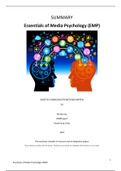Summary
Summary Essentials of Media Psychology (2019)
- Course
- Institution
This summary of Essentials of Media Psychology summaries all lectures that have been given in 2019. This summary also includes summaries of the articles. There are some terms which are translated into Dutch.
[Show more]



